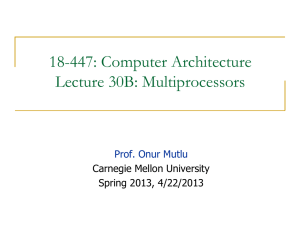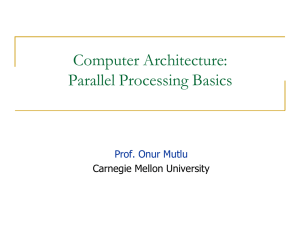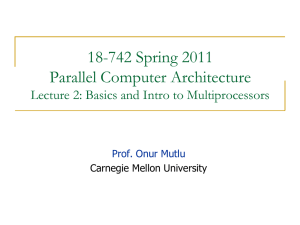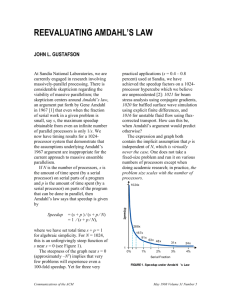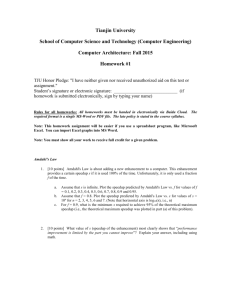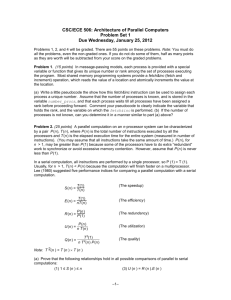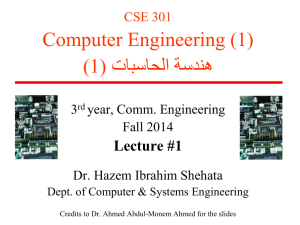Computer Architecture: Parallel Processing Basics Onur Mutlu & Seth Copen Goldstein
advertisement
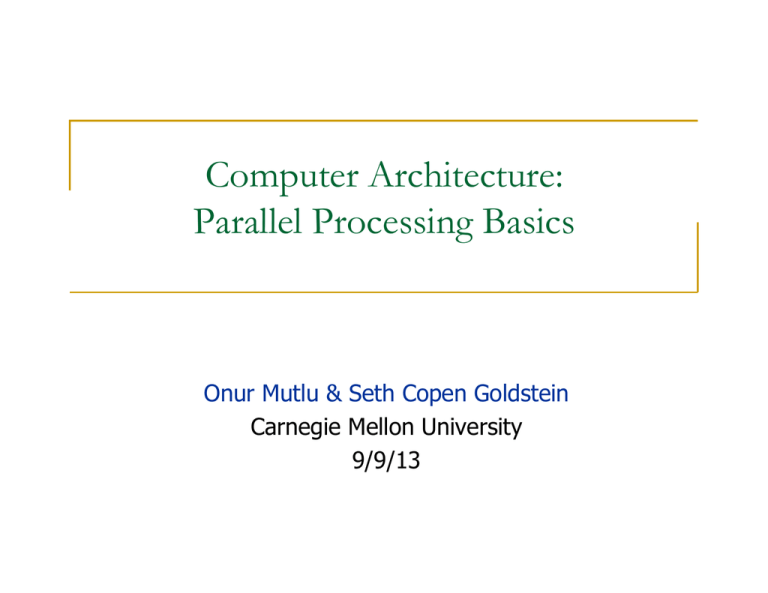
Computer Architecture: Parallel Processing Basics Onur Mutlu & Seth Copen Goldstein Carnegie Mellon University 9/9/13 Today What is Parallel Processing? Why? Kinds of Parallel Processing Multiprocessing and Multithreading Measuring success Speedup Amdhal’s Law Bottlenecks to parallelism 2 Concurrent Systems Embedded-Physical Distributed Claytronics Sensor Networks Concurrent Systems Embedded-Physical Distributed Claytronics Sensor Networks Geographically Distributed Internet Power Grid Concurrent Systems Embedded-Physical Distributed Claytronics Geographically Distributed Internet Sensor Networks Power Grid Cloud Computing EC2 Tashi PDL'09 © 2007-9 Goldstein 5 Concurrent Systems Embedded-Physical Distributed Claytronics Sensor Networks Geographically Distributed Internet Cloud Computing Parallel Power Grid EC2 Tashi PDL'09 © 2007-9 Goldstein 6 Concurrent Systems Physical Geographical Cloud Parallel Geophysical location +++ ++ --- --- Relative location +++ +++ + - ++++ +++ ++ -++ Number of Processors +++ +++ + +- Network structure varies varies fixed fixed --- --- + + Faults Network connectivity 7 Concurrent System Challenge: Programming The old joke: How long does it take to write a parallel program? One Graduate Student Year 8 Parallel Programming Again?? Increased demand (multicore) Increased scale (cloud) Improved compute/communicate Change in Application focus Irregular Recursive data structures PDL'09 © 2007-9 Goldstein 9 Why Parallel Computers? Parallelism: Doing multiple things at a time Things: instructions, operations, tasks Main (historical?) Goal Improve performance (Execution time or task throughput) Execution time of a program governed by Amdahl’s Law Other (more recent) Goals Reduce power consumption Improve cost efficiency and scalability, reduce complexity If task is parallel, more slower units consume less power than 1 faster unit P = ½CVF2 and V F Harder to design a single unit that performs as well as N simpler units Improve dependability: Redundant execution in space 10 What is Parallel Architecture? A parallel computer is a collection of processing elements that cooperate to solve large problems fast Some broad issues: Resource Allocation: Data access, Communication and Synchronization how large a collection? how powerful are the elements? how much memory? how do the elements cooperate and communicate? how are data transmitted between processors? what are the abstractions and primitives for cooperation? Performance and Scalability how does it all translate into performance? how does it scale? Flynn’s Taxonomy of Computers Mike Flynn, “Very High-Speed Computing Systems,” Proc. of IEEE, 1966 SISD: Single instruction operates on single data element SIMD: Single instruction operates on multiple data elements MISD: Multiple instructions operate on single data element Array processor Vector processor Closest form?: systolic array processor, streaming processor MIMD: Multiple instructions operate on multiple data elements (multiple instruction streams) Multiprocessor Multithreaded processor 13 Types of Parallelism and How to Exploit Them Instruction Level Parallelism Data Parallelism Different instructions within a stream can be executed in parallel Pipelining, out-of-order execution, speculative execution, VLIW Dataflow Different pieces of data can be operated on in parallel SIMD: Vector processing, array processing Systolic arrays, streaming processors Task Level Parallelism Different “tasks/threads” can be executed in parallel Multithreading Multiprocessing (multi-core) 14 Task-Level Parallelism: Creating Tasks Partition a single problem into multiple related tasks (threads) Explicitly: Parallel programming Easy when tasks are natural in the problem Difficult when natural task boundaries are unclear Transparently/implicitly: Thread level speculation Web/database queries Partition a single thread speculatively Run many independent tasks (processes) together Easy when there are many processes Batch simulations, different users, cloud computing workloads Does not improve the performance of a single task 15 Multiprocessing Fundamentals 16 Multiprocessor Types Loosely coupled multiprocessors No shared global memory address space Multicomputer network Usually programmed via message passing Network-based multiprocessors Explicit calls (send, receive) for communication Tightly coupled multiprocessors Shared global memory address space Traditional multiprocessing: symmetric multiprocessing (SMP) Existing multi-core processors, multithreaded processors Programming model similar to uniprocessors (i.e., multitasking uniprocessor) except Operations on shared data require synchronization 17 Main Issues in Tightly-Coupled MP Shared memory synchronization Cache consistency More commonly called cache coherence Ordering of memory operations Locks, atomic operations What should the programmer expect the hardware to provide? Resource sharing, contention, partitioning Communication: Interconnection networks Load imbalance 18 Aside: Hardware-based Multithreading Idea: Multiple threads execute on the same processor with multiple hardware contexts; hardware controls switching between contexts Coarse grained Fine grained Quantum based Event based (switch-on-event multithreading) Cycle by cycle Thornton, “CDC 6600: Design of a Computer,” 1970. Smith, “A pipelined, shared resource MIMD computer,” ICPP 1978. Simultaneous Can dispatch instructions from multiple threads at the same time Good for improving utilization of multiple execution units 19 Metrics of Multiprocessors 20 Parallel Speedup Time to execute the program with 1 processor divided by Time to execute the program with N processors 21 Parallel Speedup Example a4x4 + a3x3 + a2x2 + a1x + a0 Assume each operation 1 cycle, no communication cost, each op can be executed in a different processor How fast is this with a single processor? Assume no pipelining or concurrent execution of instructions How fast is this with 3 processors? 22 23 24 Speedup with 3 Processors 25 Revisiting the Single-Processor Algorithm Horner, “A new method of solving numerical equations of all orders, by continuous approximation,” Philosophical Transactions of the Royal Society, 1819. 26 27 Takeaway To calculate parallel speedup fairly you need to use the best known algorithm for each system with N processors If not, you can get superlinear speedup 28 Superlinear Speedup Can speedup be greater than P with P processing elements? Consider: Cache effects Memory effects Working set Happens in two ways: Unfair comparisons Memory effects 29 Utilization, Redundancy, Efficiency Traditional metrics Utilization: How much processing capability is used U = (# Operations in parallel version) / (processors x Time) Redundancy: how much extra work is done with parallel processing Assume all P processors are tied up for parallel computation R = (# of operations in parallel version) / (# operations in best single processor algorithm version) Efficiency E = (Time with 1 processor) / (processors x Time with P processors) E = U/R 30 Utilization of a Multiprocessor 31 32 Amdahl’s law You plan to visit a friend in Normandy France and must decide whether it is worth it to take the Concorde SST ($3,100) or a 747 ($1,021) from NY to Paris, assuming it will take 4 hours Pgh to NY and 4 hours Paris to Normandy. time NY->Paris 747 8.5 hours SST 3.75 hours total trip time speedup over 747 16.5 hours 11.75 hours 1 1.4 Taking the SST (which is 2.2 times faster) speeds up the overall trip by only a factor of 1.4! Amdahl’s law (cont) Old program (unenhanced) T1 T2 Old time: T = T1 + T2 T1 = time that can NOT be enhanced. T2 = time that can be enhanced. New program (enhanced) T1’ = T1 T2’ <= T2 New time: T’ = T1’ + T2’ Speedup: Soverall = T / T’ T2’ = time after the enhancement. Amdahl’s law (cont) Two key parameters: Fenhanced = T2 / T (fraction of original time that can be improved) Senhanced = T2 / T2’ (speedup of enhanced part) T’ = T1’ + T2’ = T1 + T2’ = T(1-Fenhanced) + T2’ [by def of Senhanced] = T(1-Fenhanced) + (T2/Senhanced) = T(1-Fenhanced) + T(Fenhanced /Senhanced) [by def of Fenhanced] = T((1-Fenhanced) + Fenhanced/Senhanced) Amdahl’s Law: Soverall = T / T’ = 1/((1-Fenhanced) + Fenhanced/Senhanced) Key idea: Amdahl’s law quantifies the general notion of diminishing returns. It applies to any activity, not just computer programs. Amdahl’s law (cont) Trip example: Suppose that for the New York to Paris leg, we now consider the possibility of taking a rocket ship (15 minutes) or a handy rip in the fabric of spacetime (0 minutes): 747 SST rocket rip time NY->Paris 8.5 hours 3.75 hours 0.25 hours 0.0 hours total trip time 16.5 hours 11.75 hours 8.25 hours 8 hours speedup over 747 1 1.4 2.0 2.1 Amdahl’s law (cont) Useful corollary to Amdahl’s law: 1 <= Soverall <= 1 / (1 - Fenhanced) Fenhanced Max Soverall Fenhanced Max Soverall 0.0 1 0.9375 16 0.5 2 0.96875 32 0.75 4 0.984375 64 0.875 8 0.9921875 128 Moral: It is hard to speed up a program. Moral++ : It is easy to make premature optimizations. Caveats of Parallelism (I) 38 Amdahl’s Law Amdahl, “Validity of the single processor approach to achieving large scale computing capabilities,” AFIPS 1967. 39 Caveats of Parallelism (I): Amdahl’s Law Amdahl’s Law f: Parallelizable fraction of a program P: Number of processors 1 Speedup = 1-f + f P Amdahl, “Validity of the single processor approach to achieving large scale computing capabilities,” AFIPS 1967. Maximum speedup limited by serial portion: Serial bottleneck 40 Amdahl’s Law Implication 1 41 Amdahl’s Law Implication 2 42 Sequential Bottleneck N=10 N=100 1 0.96 0.92 0.88 0.84 0.8 0.76 0.72 0.68 0.64 0.6 0.56 0.52 0.48 0.44 0.4 0.36 0.32 0.28 0.24 0.2 0.16 0.12 0.08 0.04 N=1000 0 200 190 180 170 160 150 140 130 120 110 100 90 80 70 60 50 40 30 20 10 0 f (parallel fraction) 43 Why the Sequential Bottleneck? Parallel machines have the sequential bottleneck Main cause: Non-parallelizable operations on data (e.g. nonparallelizable loops) for ( i = 0 ; i < N; i++) A[i] = (A[i] + A[i-1]) / 2 Single thread prepares data and spawns parallel tasks (usually sequential) 44 Another Example of Sequential Bottleneck 45 Implications of Amdahl’s Law on Design CRAY-1 Russell, “The CRAY-1 computer system,” CACM 1978. Well known as a fast vector machine 8 64-element vector registers The fastest SCALAR machine of its time! Reason: Sequential bottleneck! 46 Caveats of Parallelism (II) Amdahl’s Law f: Parallelizable fraction of a program P: Number of processors 1 Speedup = 1-f + f P Amdahl, “Validity of the single processor approach to achieving large scale computing capabilities,” AFIPS 1967. Maximum speedup limited by serial portion: Serial bottleneck Parallel portion is usually not perfectly parallel Synchronization overhead (e.g., updates to shared data) Load imbalance overhead (imperfect parallelization) Resource sharing overhead (contention among N processors) 47 Bottlenecks in Parallel Portion Synchronization: Operations manipulating shared data cannot be parallelized Locks, mutual exclusion, barrier synchronization Communication: Tasks may need values from each other - Causes thread serialization when shared data is contended Load Imbalance: Parallel tasks may have different lengths Due to imperfect parallelization or microarchitectural effects - Reduces speedup in parallel portion Resource Contention: Parallel tasks can share hardware resources, delaying each other Replicating all resources (e.g., memory) expensive - Additional latency not present when each task runs alone 48 Difficulty in Parallel Programming Little difficulty if parallelism is natural Big difficulty is in “Embarrassingly parallel” applications Multimedia, physical simulation, graphics Large web servers, databases? Harder to parallelize algorithms Getting parallel programs to work correctly Optimizing performance in the presence of bottlenecks Much of parallel computer architecture is about Designing machines that overcome the sequential and parallel bottlenecks to achieve higher performance and efficiency Making programmer’s job easier in writing correct and highperformance parallel programs 49 Parallel and Serial Bottlenecks How do you alleviate some of the serial and parallel bottlenecks in a multi-core processor? We will return to this question in the next few lectures Reading list: Annavaram et al., “Mitigating Amdahl’s Law Through EPI Throttling,” ISCA 2005. Suleman et al., “Accelerating Critical Section Execution with Asymmetric Multi-Core Architectures,” ASPLOS 2009. Joao et al., “Bottleneck Identification and Scheduling in Multithreaded Applications,” ASPLOS 2012. Ipek et al., “Core Fusion: Accommodating Software Diversity in Chip Multiprocessors,” ISCA 2007. Hill and Marty, “Amdahl’s Law in the Multi-Core Era,” IEEE Computer 2008. 50 Bottlenecks in the Parallel Portion Amdahl’s Law does not consider these How do synchronization (e.g., critical sections), and load imbalance, resource contention affect parallel speedup? Can we develop an intuitive model (like Amdahl’s Law) to reason about these? Example papers: A research topic Eyerman and Eeckhout, “Modeling critical sections in Amdahl's law and its implications for multicore design,” ISCA 2010. Suleman et al., “Feedback-driven threading: power-efficient and high-performance execution of multi-threaded workloads on CMPs,” ASPLOS 2008. Need better analysis of critical sections in real programs 51 Readings Required Hill, Jouppi, Sohi, “Multiprocessors and Multicomputers,” pp. 551560 in Readings in Computer Architecture. Hill, Jouppi, Sohi, “Dataflow and Multithreading,” pp. 309-314 in Readings in Computer Architecture. Suleman et al., “Accelerating Critical Section Execution with Asymmetric Multi-Core Architectures,” ASPLOS 2009. Joao et al., “Bottleneck Identification and Scheduling in Multithreaded Applications,” ASPLOS 2012. Recommended Culler & Singh, Chapter 1 Mike Flynn, “Very High-Speed Computing Systems,” Proc. of IEEE, 1966 52 Related Video 18-447 Spring 2013 Lecture 30B: Multiprocessors http://www.youtube.com/watch?v=7ozCK_Mgxfk&list=PL5PH m2jkkXmidJOd59REog9jDnPDTG6IJ&index=31 53 Computer Architecture: Parallel Processing Basics Prof. Onur Mutlu Carnegie Mellon University Backup slides 55 Readings Required Hill, Jouppi, Sohi, “Multiprocessors and Multicomputers,” pp. 551560 in Readings in Computer Architecture. Hill, Jouppi, Sohi, “Dataflow and Multithreading,” pp. 309-314 in Readings in Computer Architecture. Suleman et al., “Accelerating Critical Section Execution with Asymmetric Multi-Core Architectures,” ASPLOS 2009. Joao et al., “Bottleneck Identification and Scheduling in Multithreaded Applications,” ASPLOS 2012. Recommended Culler & Singh, Chapter 1 Mike Flynn, “Very High-Speed Computing Systems,” Proc. of IEEE, 1966 56 Referenced Readings (I) Thornton, “CDC 6600: Design of a Computer,” 1970. Smith, “A pipelined, shared resource MIMD computer,” ICPP 1978. Horner, “A new method of solving numerical equations of all orders, by continuous approximation,” Philosophical Transactions of the Royal Society, 1819. Amdahl, “Validity of the single processor approach to achieving large scale computing capabilities,” AFIPS 1967. Russell, “The CRAY-1 computer system,” CACM 1978. 57 Referenced Readings (II) Annavaram et al., “Mitigating Amdahl’s Law Through EPI Throttling,” ISCA 2005. Suleman et al., “Accelerating Critical Section Execution with Asymmetric Multi-Core Architectures,” ASPLOS 2009. Joao et al., “Bottleneck Identification and Scheduling in Multithreaded Applications,” ASPLOS 2012. Ipek et al., “Core Fusion: Accommodating Software Diversity in Chip Multiprocessors,” ISCA 2007. Hill and Marty, “Amdahl’s Law in the Multi-Core Era,” IEEE Computer 2008. Eyerman and Eeckhout, “Modeling critical sections in Amdahl's law and its implications for multicore design,” ISCA 2010. Suleman et al., “Feedback-driven threading: power-efficient and highperformance execution of multi-threaded workloads on CMPs,” ASPLOS 2008. 58 Related Video 18-447 Spring 2013 Lecture 30B: Multiprocessors http://www.youtube.com/watch?v=7ozCK_Mgxfk&list=PL5PH m2jkkXmidJOd59REog9jDnPDTG6IJ&index=31 59
